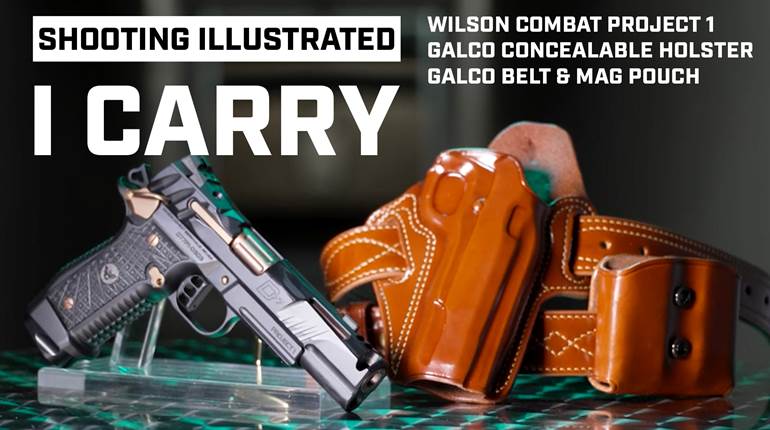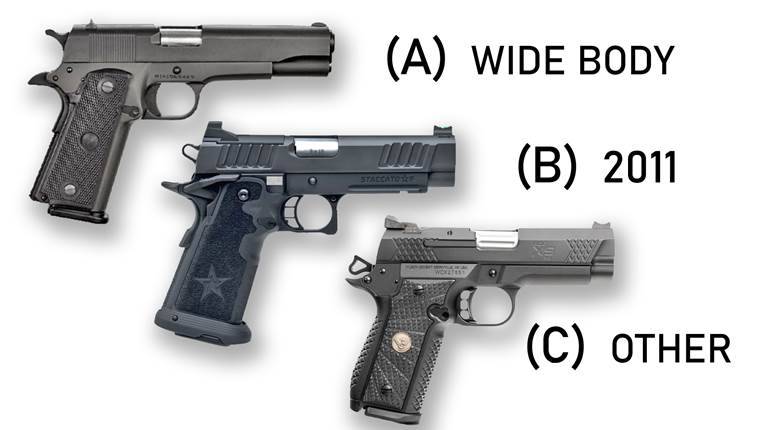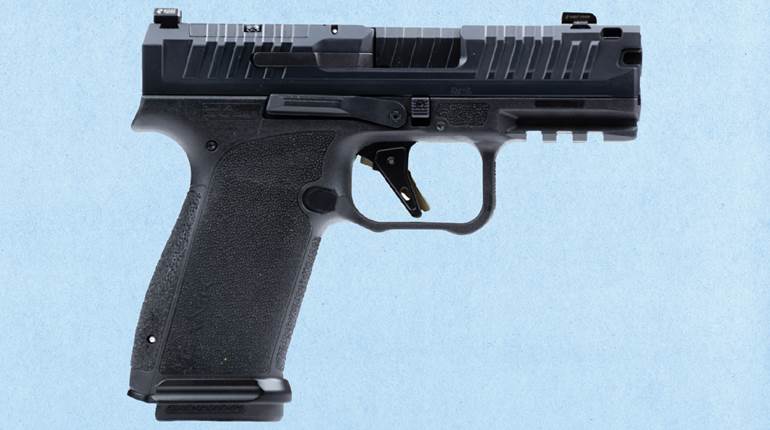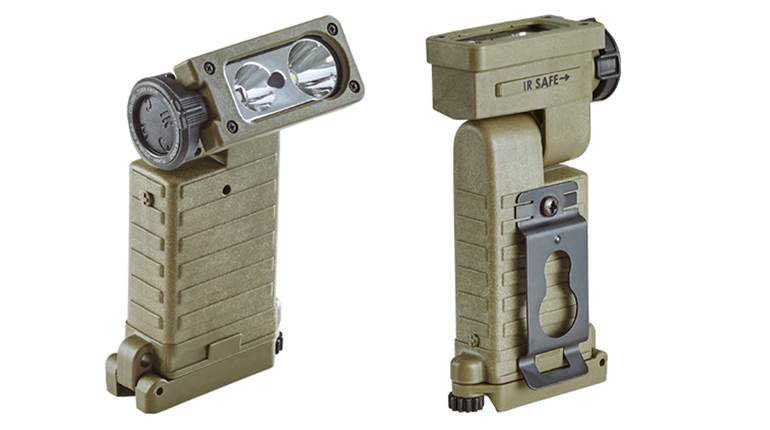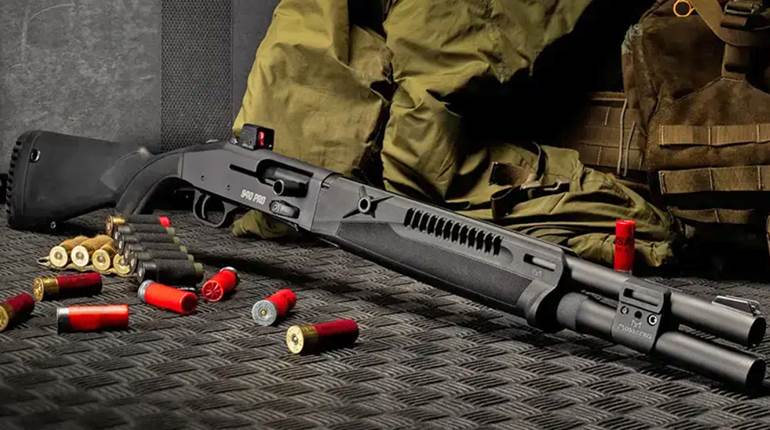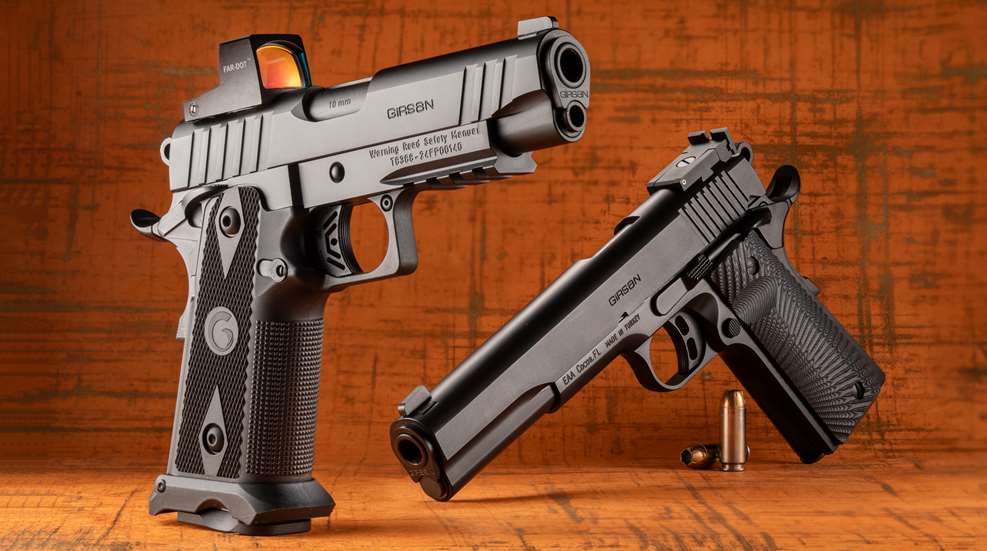
The European American Armory (EAA) Witness2311 combines three trends currently on the rise. The first is of a double-stack M1911 with a hybrid frame, the second is the seemingly metamorphic rise of a cartridge that is now more than 40 years old—the 10 mm Auto—and the third, what really sets the gun apart, is affordability. The pistol is built to EAA’s specifications by Girsan in Giresun, Turkey. You may have seen the company’s contemporary rendition of the High Power, the MCP35 PI Ops that notched a Golden Bullseye Award for Handgun Of The Year in 2024. Both come from a spanking-new, modern facility with good management, a lot of tooling, modern CNC machines and plenty of capacity. I should know—I’ve been there. Girsan makes everything from pump shotguns to M1911s.
And now it makes the EAA Witness2311. Don’t ask me why the company omitted the space. Witness is a trademark used for years by EAA, previously on Tanfoglio guns, which are no longer imported by the company. The 2311 implies modernity and likely avoids another company’s trademark. More on that later.
Although we are looking at a perfect storm of an optics-ready, affordable, concealable widebody chambered in 10 mm for this story, the Witness2311 line includes guns in 9 mm Luger, 10 mm Auto and .45 ACP in barrel lengths of 3.4", 4.25", 5" and 6". For now, they are all in Henry Ford’s favorite color, black, in this case in a Cerakote finish on all major metal parts, but that will probably change in the future.
Widebodies Everywhere
Once, they were rare: M1911 “widebodies” or “double-stacks” as we used to call them—but these days, they are ubiquitous. For most of its existence and mine, though, the M1911 was a single-stack holding seven, maybe eight, rounds of .45 ACP. Today’s double-stack M1911 trend started with cast steel frames from Ontario, Canada, then complete guns were available from Para-Ordnance by 1988. Fourteen rounds of .45 ACP was a big deal back then. There was also the Israeli-made, polymer BUL M5.
Then came the STI (for Strayer Tripp Intl.). Sandy Strayer and Virgil Tripp’s company came up with a double-stack, at first for competitors, now for seemingly everyone, that used a modular hybrid frame: steel for the slide rails and pins for locating the safety, hammer, sear and disconnector and a replaceable polymer lower for housing the mainspring, trigger and magazine release. It had various names, but eventually, 2011 stuck. Today, this has become shorthand for the entire class of guns—although trademarked and vigorously defended by its owner, which changed its name in 2020. These guns are now made by Staccato in Texas, the market leader. The Witness2311 follows the pattern set—and employed by others since—by the then-STI and now-Staccato 2011s.
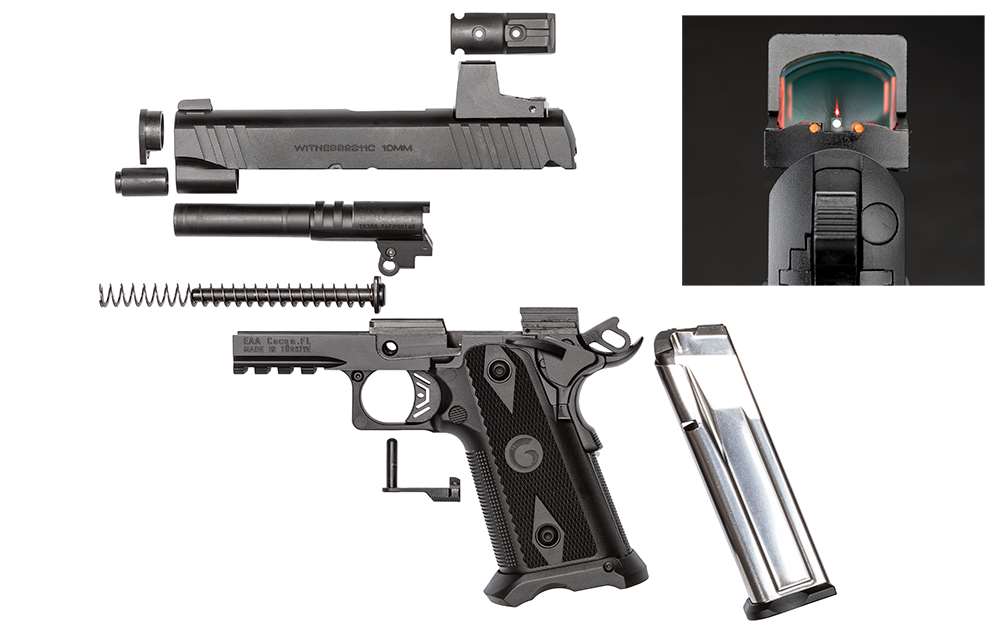
The 10 mm Auto: It's Actually A Thing
“If I were to vote on the most significant development in handguns in recent memory, it would be, without hesitation, the 10 mm Auto.” Those words were written for the July 1988 issue of American Rifleman by my late friend, Contributing Editor Charles E. Petty. Back then, Charlie was our main guy when it came to handgun ammunition. He continued, “The 10 mm is important because it brings true middle-magnum power to an automatic pistol of average size.”
Introduced in 1983 with the Bren Ten pistol as made by Dornaus & Dixon, the 10 mm Auto was initially loaded by Norma and even got an endorsement from Col. Jeff Cooper himself. Out of the gate, the 10 mm propelled a 200-grain bullet at 1,260 f.p.s., delivering 704 ft.-lbs. of energy from a 5" barrel. Eventually, Hornady joined Norma in producing factory ammunition in the middle 1980s, which served to help mainstream the cartridge. As this was written, I found 55 different factory loads offered by MidwayUSA on a random Tuesday afternoon. Bullet weights include 70 (Liberty Overwatch), 135, 150, 155, 175, 180, 200, 215 and 220 grains. All in stock. The vast majority of offerings are either 180 or 200 grains.
Everyone seems to be talking about 10 mm these days, but is it just bored gunwriters? I’ve been talking to ammunition makers, big and small, who would be in the position to actually know. It’s not just hype. A lot of 10 mms, millions of rounds, probably tens of millions—no one would go on record with a specific number—get made and sold every year by multiple ammunition manufacturers. You have a long case measuring 0.992" that can be generously filled with powder and a cartridge overall length of 1.260". Think of the 10 mm as the Hemi of semi-automatic pistols.
“A cartridge that was designed to produce energy greater than standard .357 Mag. ammunition in a semi-automatic, the 10 mm offers tremendous versatility across a wide variety of bullet weights,” said our resident 10 mm enthusiast and Shooting Illustrated Associate Editor Bob Boyd. “That versatility, combined with the cartridge’s extremely flat trajectory, is the reason for the cartridge’s enduring popularity—one that has spanned more than 40 years—and I suspect it’s a contributing factor as to why the gun industry continues to produce handguns, pistol-caliber carbines and rifles chambered for the powerhouse today. Whether your interest is target-shooting, hunting or self-defense, the 10 mm is more than up to the task.”
Digging Into The Witness2311
With the 2311, most critical components are in the steel upper frame, which is also the serialized part or receiver, according to BATFE. These include the slide rails, the safety, hammer, sear, disconnector and their associated pins. The upper frame, of course, is steel, and it is joined to the polymer lower by what would conventionally have been the top grip screws as well as a Chicago-style screw that passes through the trigger guard’s front. The upper frame has contours that match up with and aid the screws in keeping the lower in position. The trigger, mainspring, its housing and magazine catch are attached to the lower frame.
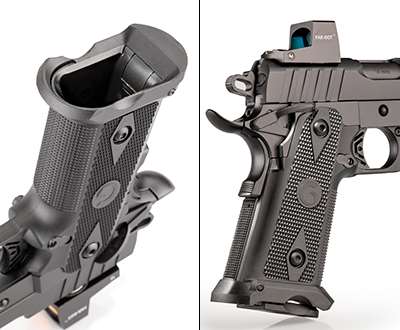
The top of the frame is conventional at its front, but then flares outward where the wider-than-standard magazine comes up through the grip. It comes with a pronounced beavertail grip safety—not a chance of hammer bite here. The slide lock is on the frame’s left in the conventional position. That said, the extended manual safeties are bilateral and oversize. The grooved magazine release is found on the frame’s left side; it is not reversible.
With a polymer lower frame, you can mold in a lot of detail. For example, fine frontstrap checkering (in this case, very conventional, at about 24 l.p.i.) helps anchor the pistol without expensive machining. The frame sides have an updated version of traditional double-diamond checkering. The aluminum mainspring housing also has fine checkering. And at the frame’s bottom is a flared and expanded magazine well. Retained by the mainspring housing pin, its front protrudes forward, which, during shooting, helps the gun from twisting upward in the hand, almost acting as a stop.
On the 2311, EAA uses the traditional swinging-link system of the M1911. There are two lugs on the barrel’s top that engage corresponding recesses in the underside of the slide, completely familiar to most M1911 fans. There is an internal extractor on the breechface’s right, and a beefy ejector that also incorporates some slide rail is at the left rear of the frame. There is a traditional barrel bushing, but there is a seriously beefed-up flat coil spring—to tame the mighty 10 mm—as well as a one-piece, full-length guide rod topped with a recoil spring plug. Disassembly is no different than most M1911s.
The U.S.-made magazine is from Check-Mate and is a double-stack that constricts down to single feed and holds up to 15 rounds. The body is of stainless steel, and the plastic baseplate has finger grooves on either side that mate up to recesses in the flared magazine-well extension.
Sights on the Witness2311 start with a white-dot front dovetailed into the slide. The rear is where it gets interesting; the gun I tested came with a polymer Far-Dot with a solar panel installed. This is a micro red-dot made for EAA that is built on the Shield footprint and will only come with the company’s first 3,000 optics-ready guns. It is secured by two screws and is adjustable for windage and elevation. Those adjustments are not terribly intuitive and involve a screwdriver and an odd wheel, but after some fiddling, zeroing was no problem.
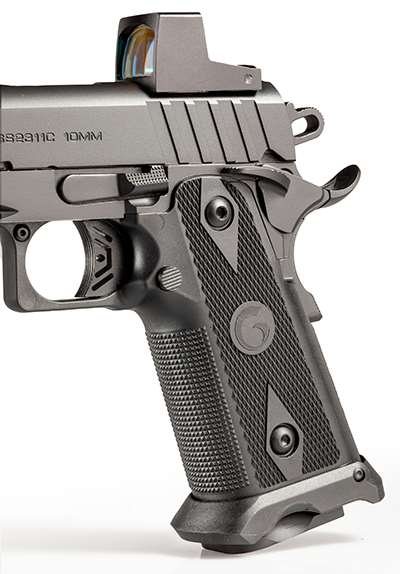
At the rear surface of the Far-Dot are two red dots, as well as a wide sight notch built into the base. The sights and the red-dot reticle, with adjustment, co-witnessed on the shooting sample. To change the CR2032 battery on the sight, you need to remove the unit, as it is underneath and was even slightly visible while the optic was mounted. This visibility proved to be a problem. There was supposed to be a gasket between the battery and the top of the slide cut. This led to erratic function of the unit—caused by the battery moving and contacting the slide—until we received and installed the gasket. At that point there were no further issues with the Far-Dot.
If you are not a part of the red-dot revolution, EAA supplies a two white-dot, combat-style rear sight plate attached by two screws for those who want to go with irons. That said, the replacement plate is not adjustable for windage or elevation. Discussions are ongoing on a target-style, fully adjustable version as employed on other Girsans made for EAA.
The 10 mm is a different level of power than the 9 mm. Having fired the Witness2311 in 9 mm, in both 4.25" and 6" barrel lengths, upping the gun to 10 mm Auto makes for a brisker experience. After early testing, EAA added a liquid thread locker to the screws securing the frame assemblies and the Far-Dot sight. The frame screws stayed tight and put, but we did have the sight screws work loose—partly due to the missing gasket.
Home On The Range
At the range, despite its compact 4.25" barrel, the test Witness2311 was quite manageable. Part of this is attributable to the excellent checkering on the frontstrap and the mainspring housing. That and the flared magazine well helped the gun stay put in the hands, even during rapid-fire strings.
An interesting phenomenon developed with the aluminum trigger. It has a stylized “W” void (presumably for Witness) cut into its side and has a grooved front face. But its dual bars ride in recesses inside the polymer frame. Out of the box, the single-action trigger was coming in at a gritty 7-lb., 13-oz., pull. As the gun was fired, whatever slight irregularities may have been in the polymer channel inside the frame for the trigger bars smoothed out, delivering a much better 5-lb., 9-oz., pull after about 100 rounds. After that, pull weight remained constant within an ounce over 10 measurements.
Even with the hottest loads we fired, the 2311 in 4.25" was at times snappy, but not unduly punishing. Slide velocity was high, and there may be changes to the recoil spring in the future. There were no failures through 400 rounds from five different makers, but we did find the first round out of the magazine would often print between 1" and 3 1/2" from the main group, some of which were well under 1 1/2" for the other four shots.
Its weight and width where it interacts with the hand made it about as pleasant as 10 mm with that barrel length will likely ever get. Dare I say fun? That’s a tough word for describing a 35-oz. 10 mm. The 6" version of the Witness2311, although not the main focus here, definitely did fall into that category.
My colleague, Managing Editor Christopher Olsen, noted that with 16 rounds on board (a full magazine plus one on the chamber), even with the middle-of-the pack Hornady 180-grain XTP loading, you are looking at having the potential for 9,280 ft.-lbs. of available energy in a very compact package that you can wear comfortably in a belt holster. If that seems formidable, that’s because it is. What is not formidable on the Witness2311 is its price tag.

The Allure Of The Long Slide
The Government Model M1911 has spent most of its life in .45 ACP and with a 5" barrel. But the enduring design turns into a different animal when you add an extra inch of slide and barrel. Longslides have been with us for decades, and they started out trying to give competitive shooters a little more sight radius. You can call them hardballers or longslides, but the side effect is a little bit more barrel and, appropriately, a little more energy.
 Although the focus of this story is the 4.25" Witness2311, I had the opportunity to shoot the 6" Witness2311 and the EAA MC1911 S Hunter in 10 mm, also made by Girsan and currently available only with a Picatinny accessory rail. The latter is an all-steel single-stack weighing in at almost 40 ozs. I enjoyed shooting it so much that I had to include it. I must say that I am a fan of all-steel longslides when it comes to the 10 mm, and the EAA Hunter did not disappoint. That extra weight out front helps one control the recoil and get back on target more quickly. Even though there is more energy due to increased velocity, it feels like you are still just shooting a .45. Weight matters in the 10 mm Auto—the next time I shoot a 26.5-oz., 10 mm baby Glock 29, it will be from inside the bear.
Although the focus of this story is the 4.25" Witness2311, I had the opportunity to shoot the 6" Witness2311 and the EAA MC1911 S Hunter in 10 mm, also made by Girsan and currently available only with a Picatinny accessory rail. The latter is an all-steel single-stack weighing in at almost 40 ozs. I enjoyed shooting it so much that I had to include it. I must say that I am a fan of all-steel longslides when it comes to the 10 mm, and the EAA Hunter did not disappoint. That extra weight out front helps one control the recoil and get back on target more quickly. Even though there is more energy due to increased velocity, it feels like you are still just shooting a .45. Weight matters in the 10 mm Auto—the next time I shoot a 26.5-oz., 10 mm baby Glock 29, it will be from inside the bear.
When it comes to the MC1911 S Hunter, the company went old-school. This an all-steel gun measuring 9.63" long with its 6" barrel. Magazine capacity is eight. The front sight is dovetailed into the slide and grooved to reduce glare, while the fully adjustable rear is dovetailed in and has a square notch. The keys to controlling the mighty 10 mm are the gun’s weight and whether or not you can get a firm grip. The Hunter had both and then some. Best of all, the price is just $774.
In the accompanying table, you can see the velocity and energy results from both the 4.25" and 6" barrels. We shot our three accuracy loads plus two other representative loads over the chronograph to ascertain how much was gained by that extra 1.75" of barrel. In the accompanying table, you can see that your experience may vary. With the CCI Blazer 180-grain FMJ, there was nearly a 100 f.p.s. increase in velocity, and Double Tap provided even more than that. Interestingly, the loads geared more on the personal-defense side did not see increases nearly as substantial. As with anything else, the load you choose for your 10 mm should be optimized for the gun you choose—and its intended use.
The Shape Of Guns To Come
Remember that table at the gun show where you could get custom-molded earplugs? A guy heats some goo in water until malleable then puts it in your ear. You shop for a while and come back, and you have a set of hearing protection that will fit you specifically.
But what if you could do that with the frame of a handgun? Top-level competitors do it in wood for Olympic-level competitions with .22s or air pistols. With metal-frame guns, it takes a lot of expensive machining or hand work to get a custom fit. You can have all the checkering or scalloping or grooves or indents you want done aftermarket on a molded polymer handgun frame as well.
Thanks to advances in technology, it’s more attainable and affordable than ever to get the only part of the gun that you actually grasp while firing, the frame, custom-fit to you. While I found the ergonomics of the stock Witness2311 to be excellent, folks from 3DGrip4U demonstrated the next evolution in truly custom handgun frames in the EAA booth at the January 2024 SHOT Show. What if you could use a mold of a user’s hands as the outside contour for a polymer pistol frame?
The company is very experienced in 3D printing not only of objects, but in material, and it can customize the Witness2311 grip—or that of a similar platform pistol—to just you. This is facilitated by the polymer portion of the frame. The steel parts don’t change, just the outside of the un-serialized polymer lower. I’ve fired at least a dozen or more 3D-printed, pre-production polymer-frame guns and still retain all my fingers. As long as it holds up, what does it matter if it comes from the factory mold or a 3D printer, so long as the right material is used?
Get the supplied material to a certain malleable temperature, and then hold the frame firmly for just a few seconds in your best shooting grip. The company then takes that frame contour made by your hands and runs it through a program that is transferred to a 3D printer that, line by line, builds your grip. I watched and participated in the molding process, but have not received a completed frame/gun combination. The cost for a custom-molded frame is estimated to be in the $400 range. Note, it’s only for 2311-esque guns for now. Details can be found at 3dgrip4u.com.












